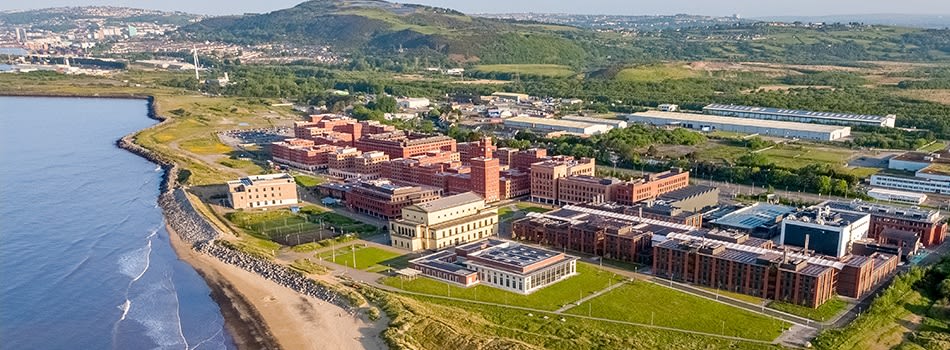About the Project
This scholarship is funded by Swansea University and Université Grenoble Alpes.
Start date: October 2020
Subject areas: Physics/Chemistry/Materials Science
Supervisors:
Professor Thierry Baron (UGA)
Professor Richard Palmer (SU)
Dr Thierry Maffeis (SU)
Project description:
Nanocrystals are defined as materials with sizes close to or below the Bohr radius of the bound state of an exciton. The quantum confinement effect is perhaps the most attractive characteristic of quantum dots (QDs), in which the motions of electrons and holes are spatially confined, and the electron and hole energy levels become discrete. The emission and absorption colour of the QDs can also be tuned by controlling their sizes and compositions; this provides access to solution-processable emitters and photodetectors covering ultraviolet (UV), visible and near-infrared (NIR) wavelengths. Therefore, QDs have enabled several recent achievements in high mobility transistors, high-quantum-yield photodetectors, light-emitting devices and high-efficiency photovoltaic devices. Probably the most popular application of semiconductor QDs is their use as red and green phosphors in white LEDs for displays, whilst the development of QDs for photodetectors has come a long way, especially for smartphone applications.
Project aims:
In this context, the aim of the PhD work is to develop a sustainable method which ultimately allow the use of QDs in emitters, photodetectors, sensors and displays. The deposition of mass-selected nanoparticles from a beam in vacuum represents a new paradigm for the creation of nanostructured materials with quantum properties. Heavy metal quantum dots, as synthesized by conventional but hazardous chemical routes, have recently found their way into high resolution TV screens, but in this project we will explore the solvent-free synthesis and deposition of mass-selected Si and Ge semiconductor nanoparticle beams into polymer films, which is an innovative, environmentally friendly, embryonic manufacturing technology. The size of the nanoparticles can be controlled with a resolution of one atom in 50 using the beam technology, and thus the colour of the emitted light will be highly tunable. The polymer film provides an electrically conducting host to feed the electroluminescence process with charge; plus protection and isolation of the nanoparticles. Atomic capping of the nanoparticles (e.g. with H atoms) during the synthetic process, to reduce non-radiative trap states, will be explored. The particles will be imaged to single atom resolution by advanced TEM techniques. The semiconductor nanoparticles will be generated in Swansea, and deposited into conducting polymer films produced by Grenoble, whilst the photoluminescence and electro-luminescence studies will be shared. Specific devices will be realized in the Advanced Technological Platform (PTA) available in Grenoble. Complementary photoluminescence measurements will also be conducted at Swansea to establish universality.
It is anticipated that the successful student will be based in Swansea for the first year, learning to operate and optimise the cluster beam deposition sources for semiconductor materials, and mastering the required characterisation techniques (notably TEM). The student will be based in UGA for the second year, with focus on photonic testing of the nanocluster-embedded polymer films. In both years the student will undertake at least one exchange visit to make and test the materials and build the collaboration. The last year will be split between the two universities. The student will be supervised professionally, providing short weekly reports to the supervisors in both Universities, and giving quarterly oral presentations. The student will benefit from an open and dynamic research environment. Apart from the technical skills learnt from mastering the operation of highly specialised vacuum equipment (cluster sources), an array of state-of-the-art characterisation techniques, and a range of advanced and innovative nanofabrication skills, the student will also benefit from 120 hrs of courses during their stay at UGA. Additionally, the student will have the opportunity to attend courses at Swansea’s Academic and Professional Centre in order to develop transferable skills such as time/project management, data analysis, statistics, thesis writing, IP management, public engagement and poster/oral presentation.
Eligibility
As this is a joint degree, applicants must meet the entry/funder requirements of both universities: a recognised master’s degree in Engineering/Physics/Chemistry /Materials science, and an appropriate English language qualification, ELTS 6.5 overall (with at least 6.5 in each individual component) or Swansea University recognised equivalent.
Due to funding restrictions, this scholarship is open to UK/EU candidates only.
Funding Notes
This scholarship covers the full cost of UK/EU tuition fees (50% by Swansea University, 50% by Université Grenoble Alpes) and an annual stipend of £15,285 reviewed annually in line with UKRI rates.
Additional funding is available from Swansea University to assist with travel, accommodation and immersive training experiences.

 Continue with Facebook
Continue with Facebook


